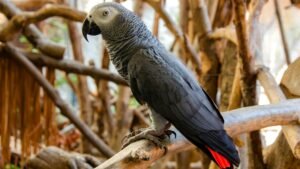They are small, experts at flying, with over 350 species; we present to you the hummingbird. Hummingbirds are a wonder, and thanks to their colorful feathers, you can’t miss them when you see them in the skies. One of the most fascinating things about hummingbirds is their numerous species. Also, they come in all shapes, sizes, and beautiful colors.
Hummingbirds are native to the Americas, and while they are relatively small birds, they eat a lot. Do you want to know another fascinating thing about these birds? Their eggs are so tiny! A ruby-throated hummingbird egg is the size of a pea. Follow us as we guide you to all things hummingbird.
Common Hummingbird Species
The hummingbird family is a very large one. Unlike the monk parakeet, the hummingbird is over 350 species strong, and about half of its species live in the equatorial belt. Also, the hummingbird has over 115 genera which are found mostly in the south of the United States. In this paragraph, we will look at some of the most common species of these small but mighty birds.
Ruby Throated Hummingbird

The ruby-throated hummingbird is similar to other members of its family in terms of size. They are small-sized. The bill of this species is one of its most recognizable features. Its bill is slender and slightly down-curved, and if you are an experienced bird watcher, you can’t miss identifying the hummingbird when you spot it because of its peculiar bill.
The wings of the ruby-throated hummingbird are short and don’t reach its tail when it is in a sitting position. The colors on this hummingbird species are amazing, for lack of a better word. Its colors are bright emerald on the back, and also its crown. The males of this species have a red-colored throat that may look dark when it isn’t in a well-lit place.
However, in adult females, the throat is white; if you look closely, you may see a buffy streak. The differences between the male and female of the ruby-throated hummingbird are subtle, but if you have some experience in bird watching, you will spot the differences.
You need to note that juvenile males may also have white color on their throats. So, be careful not to mistake the juvenile male and the adult females. You might ask how you differentiate between the juvenile male and female? It’s simple. The juvenile male’s white throat is often streaked by black or green.
By looking at their tails, you can also differentiate between a male adult ruby-throated hummingbird and a female. The males have a forked tail with pointed outer feathers that are black at the tip, while the females have a blunt rounded tail. The blunt round tail in females is black with a white tip.
Blue-headed hummingbird

If you want to see a blue-headed hummingbird, then be ready to travel to the island of Dominica and Martinique because those are the only places where they can be found. This puts them in the spot of rare hummingbirds species.
Again, like most in its family line, the blue-headed hummingbird is small, with a length of 9-8cm. The males weigh a paltry 4.7g. In sharp contrast to the ruby-throated hummingbird, which has a slender and slightly down-curved bill, the bill of a blue-headed hummingbird is straight and black. It also has a mandible that has a pink base.
Still, in a show of colors, the head of the male blue-headed hummingbird is metallic violet blue. Its back showcases the brilliance of shiny green, and its upper tail spots a deep blue. Truly, the blue-headed hummingbird is a beauty to behold; maybe that is why they are rare to see.
The blue-headed hummingbird female isn’t left out in the color beauty contest. The female’s bill is completely black, and its crown is shining green. Its cheeks are dusky, with a small grey spot placed behind the eye. Let’s not forget that the back and flanks of the female are bronze green.
Rufous Hummingbird

Rufous hummingbirds are a very common species of hummingbirds. They are also very aggressive, especially when sharing a feeder with other hummingbird species. Rufous hummingbirds breed during the summer along the North pacific coast of the United States.
Like other hummers, the rufous hummingbird is notable for its brilliant colors. The males have orange plumage and a bright orange-red throat. The females aren’t as brightly colored as their male counterparts. However, the females have a green upper part and a white chest.
Allen’s Hummingbird
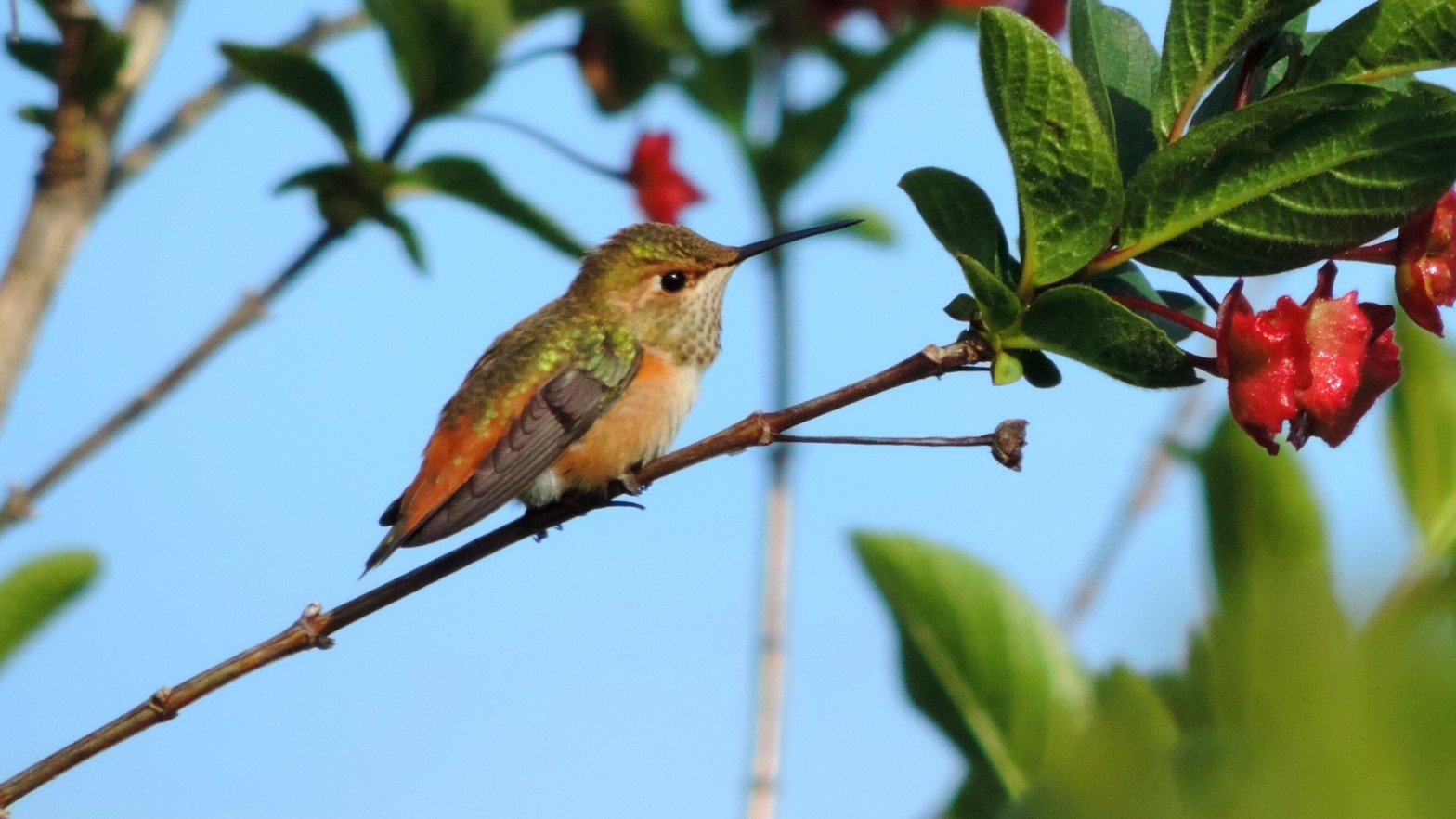
Like the rufous hummingbird species, n’s hummingbirds are also summer breeders. Apart from sharing a similar breeding season, the rufous hummingbird and Allen share a striking resemblance. This is due to the orange plumage, which they both share in common. However, a keen bird watcher can tell the difference between the two because the Allen hummingbird has a greener back and head.
The Allen hummingbird is relatively common, and they are found in suburban gardens and open wood.
Black-Chinned Hummingbird

The black-chinned hummingbird is a summer breeder found in Eastern Washington and Oregon. Black-chinned hummingbird species have also been found in the southwest parts of Texas.
The males of the Black-chinned hummingbird can be identified by their black gorget, purple throat, and white collar. They get their name “black-chinned hummingbird” because of that dark gorget. The gorget contrasts sharply with the bird’s white collar. The purple-colored feathers of this bird can be seen under bright light.
On the contrary, the females of this species have green under the upper parts and white underparts. The black-chinned hummingbird is also one of the most common western birds.
Costa’s Hummingbird
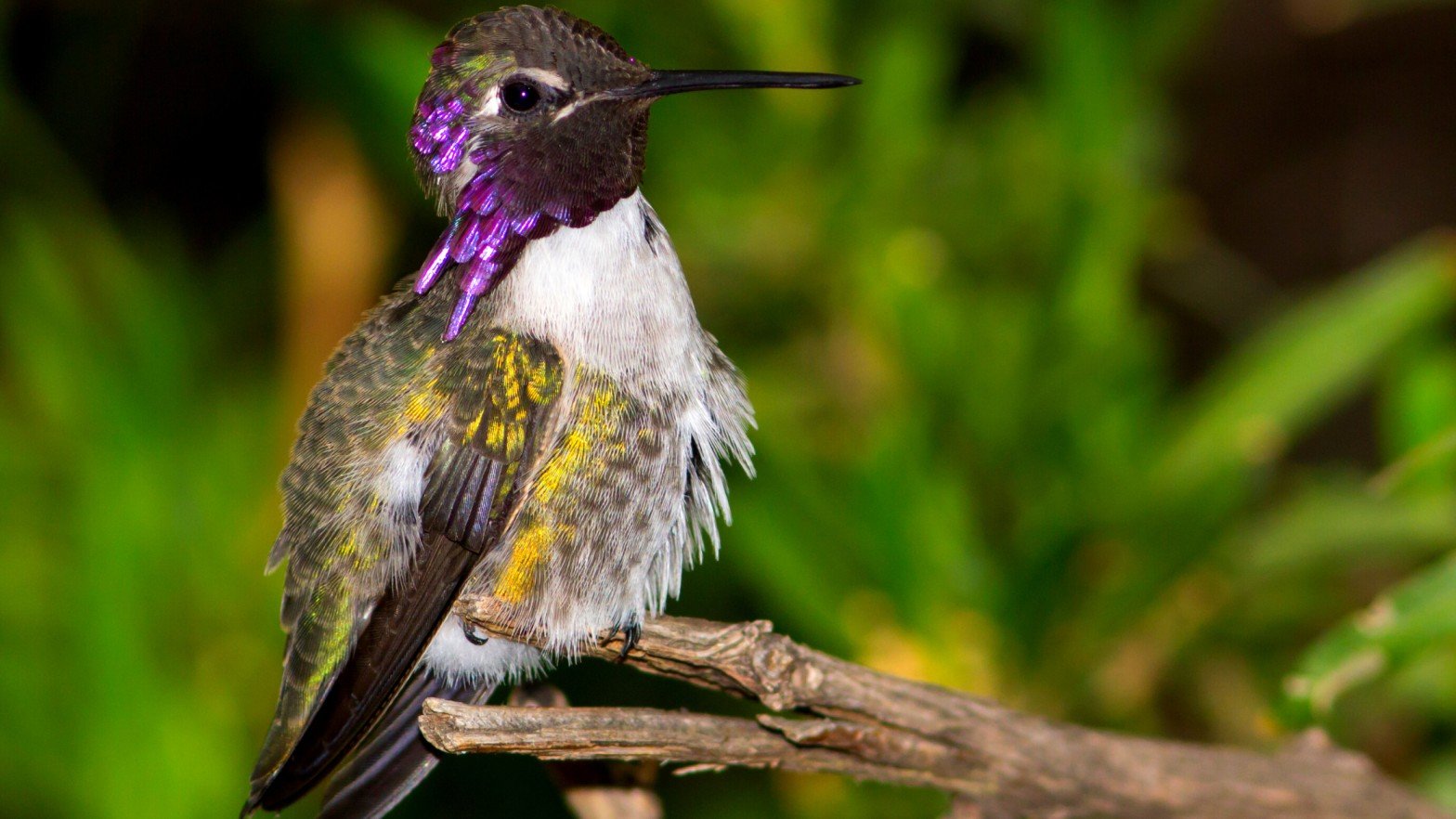
One of the best things about the Costa hummingbird species is that they can be seen all year round if you live in Southeastern California and Southwestern Arizona. The males proudly spot a pinkish crown. The crown could also be purple.
The females are left out in the contest of colors as they lack the bright pink or purple crown. However, the females have green upperparts and white under parts. The colors fade off at the sides of the birds slightly.
Costa’s Hummingbirds weigh about 2-4 grams and prefer desert climates. It is hard for them to be found in urban areas unless the resident is on the edges of the suburbs.
Calliope Hummingbird
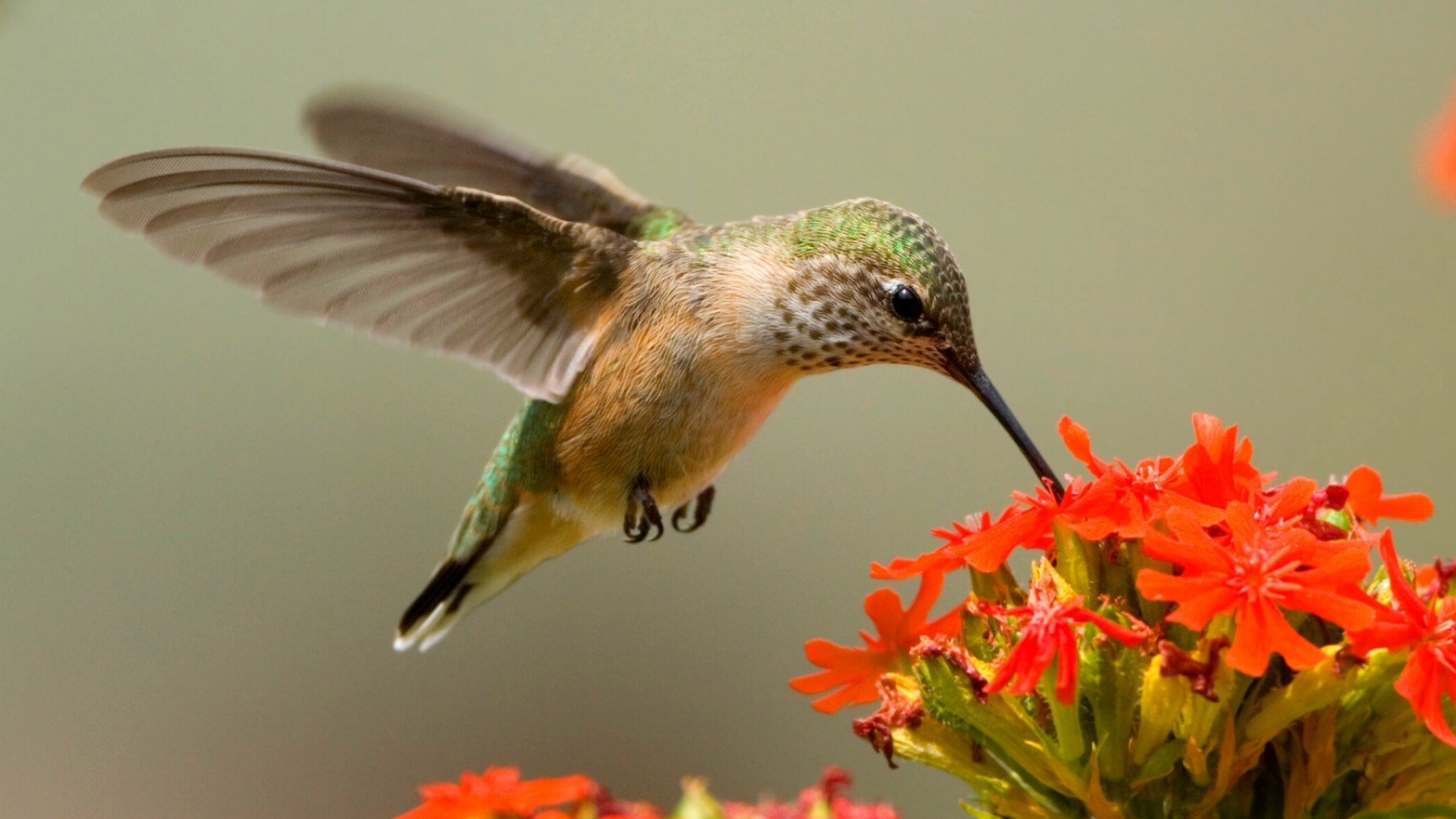
The calliope hummingbird is also another small hummingbird species. They weigh about 2-3 grams with a length of 3.25 inches. They breed in the summer in Southern British Columbia, and their breeding can go as far as Idaho and the north of Nevada.
What the calliope lacks in size, it makes up for in beauty. They are the smallest hummingbird in North America, but they boast of being the most beautiful. The males proudly spot a pink gorget that extends pointedly to the bird’s sides. The females don’t have the gorget, but they have a bright green upper part. The female’s white underparts have a slight rufous wash.
The calliope hummingbird can be found in mountainous meadows, and they like to feed from low-hanging flowers. The males are very protective of their territory. However, calliopes are considered calm when compared to other species, such as the rufous.
Violet-Crowned Hummingbird

It is hard to see the violet-crowned hummingbird bird in the United States. However, when in the United States, they can be found in southeastern Arizona. They are hardly mistaken because they have an obvious white underbelly and faded green upper parts. They also wear a crown of blue-purple, one of their most recognizable features.
The males and the females share a similar look. The main distinction between the males and the females is that the female’s colors are a bit duller. Oh, and did we mention that its bills are a distinctive red with black lips?
They are commonly seen near water sources, and their preference for sycamore trees is notable.
Lucifer Hummingbird
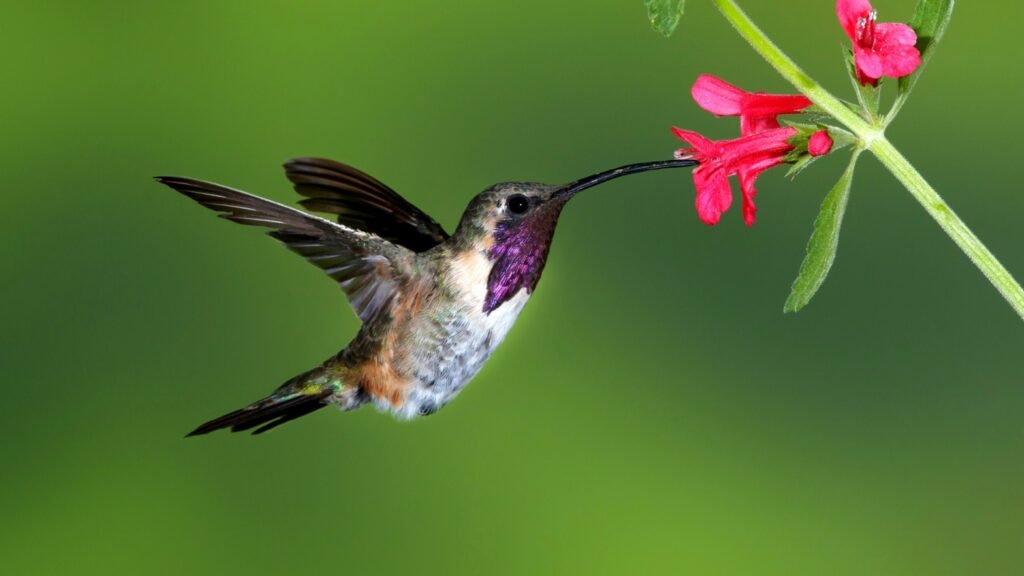
Before you turn off your phone at the mention of Lucifer, the name that must not be named, hear us out. The Lucifer hummingbird isn’t named because of any bad connotations. On the contrary, the Lucifer hummingbird is a very beautiful species, although they are rare.
They are found in Northern America. The males have a beautiful purple throat, a green upper part, and flanks. The males also have a forked tail that is notable for its dark color. The females of the Lucifer hummingbird are also very beautiful. They spot a green underpart, easily identifiable because of their blurry gray ear streak.
Lucifer hummingbirds are rare because they like to stay in deserts. They rarely visit backyards and will hardly be seen drinking from feeders.
Plain-Capped Starthroat

The plain-capped starthroat isn’t a very beautiful bird compared to other hummingbird species. Their colors are dull. They have a brown-green plumage, and their underparts are colored gray.
The plain-capped starthroat is identifiable through the white whiskers it possesses. It also wears a white line just behind its eyes. This species also has a red patch that is hardly seen except in good light.
Thankfully, these hummingbird species are regular visitors to feeders so you may be able to spot them if you hang a hummingbird feeder in your yard at the right time. They are solitary and territorial.
Behavior of Hummingbirds
If you read our article on the monk parakeet, you’d remember that we said they are very social birds. They get depressed if they are ignored for too long. Hummingbirds are a sharp contrast to monk parakeets. Hummingbirds aren’t social; they live solitary lives. They are introverts and like to be left alone. You won’t see them migrating in groups or living together in large groups either.
On rare occasions, they may come together to share a quick snack as they fly through the town, but this isn’t a frequent behavior. How do these birds live, then? They simply divide themselves into territories. When hummingbirds are about to divide themselves, they share territories based on water, food, and nectar.
The males protect their territories with a lot of aggression.
On the other hand, females choose their territories based on the nests they can build. When the females choose their territories, they defend them just as fiercely as the males. We’d take a harder look at some of the behaviors that define these brightly colored birds when they are in the wild. We do not know how they behave as pets because it is illegal to own a hummingbird.
- They Groom Thoroughly
Hummingbirds are clean freaks. We’d probably diagnose them as having a compulsive disorder if they were human. Hummingbirds often groom themselves using their bills and claws to remove dirt from their bodies. They use an oil gland near their tail to cover their wings, keeping them clean. These birds are so conscious about keeping clean that they will rub themselves against a twig when they can’t reach certain places in their body.
Did you know that hummingbirds also like to bathe? Yes, they are that clean. They will regularly fly through misty water and rub themselves against wet leaves. When they are in the water, they flutter their wings and tail, using the water splash to clean themselves. These guys are the cats of the bird world!
- Highly Cerebral
“Birds are dumb.” That quote doesn’t apply to hummingbirds. Hummingbirds are very intelligent, and in fact, they have the largest brain size-to-body ratio in the animal kingdom. Hummingbirds have an awesome memory, knowing every flower in their territory. In addition to knowing every flower in their territory, hummingbirds also know when those flowers will refill.
Get this; Young female hummingbirds have been known to watch older female hummingbirds build nests in a bid to learn. They can also quickly identify the people responsible for filling their feeders.
How Do Hummingbirds Reproduce?

The early spring is when the mating season of the hummingbird begins. Once it is late March, they will begin to return to the United States from their winter migration to Mexico. The males of most species will return about one or two weeks ahead to scout for the females. Remember that the males are territorial and will protect the territories they can scout with hyper-aggressiveness.
When the males arrive and wait for the females, and the females finally arrive the mating ritual begins. The ritual involves a flight that is showy and energetic. The males will fly in zig-zag patterns and go as high as 50-150 feet. Do you know what they will do next? They fly straight down and pull up right before impact. These males do go all out to impress don’t they?
After all the show of flight skills, the mating time involved is about three to five seconds. The males don’t have a penis, so actual penetration doesn’t occur. Mating instead takes place through the action of the male pressing his cloaca against the female. Sperm is then passed along to fertilize the egg of the female.
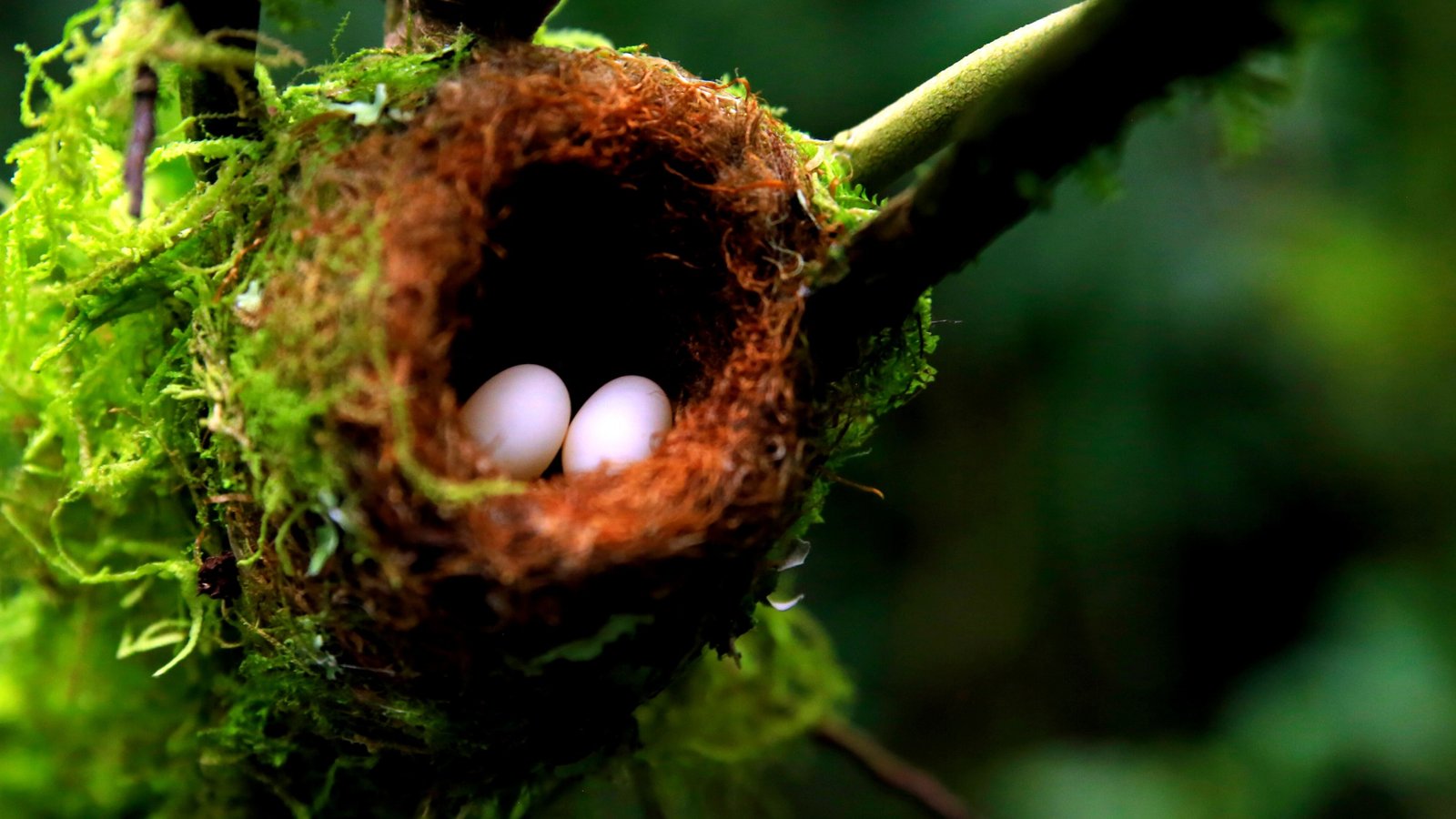
The eggs of hummingbirds are very small. This is normal, considering their size. The females usually lay two eggs a few days after making their nest. Sometimes, the female may lay one egg but laying three eggs is completely unheard of. If you are wondering why they lay only two eggs, it is because female hummingbirds can take care of only two chicks.
The male hummingbirds do not stay back to help females raise kids. They go out to mate with other females. Typical deadbeat dad, right? The hatching period for the eggs of hummingbirds is around two to three weeks. When the egg hatches, the baby hummingbirds will remain in the nest for 18 to 22 days. After 22 days, they will leave to find their food. However, they may still get fed by their moms till day 25.
Habitat of Hummingbirds
Hummingbirds live in different kinds of landscapes. They can live in temperate woodlands, cloud forests, mountain meadows, deserts, tropical rainforests, and more. Hummingbirds like to live in places that have a lot of flowers.
In terms of Nesting behavior, the females of hummingbirds do all the work. They build camouflaged nests to take care of their young, and they also provide feeding for their babies. The male hummingbirds play zero roles in raising their chicks.
Hummingbirds build their nest using dimensions of two inches in diameter. They also build their nest in a tree that has enough coverage.
Humming Bird Sound
Diet: What Do Hummingbirds Eat?

Hummingbirds are voracious eaters. They eat so much because of their high metabolism. Their survival depends on how much they can eat. These tiny birds consume half their body weight in nectar and bugs and feed every ten to fifteen minutes. They also like to eat larvae, insect eggs, and spiders.
They eat insects as a source that provides the fat, salt, and protein they cannot get in nectar. When they aren’t able to get nectar, hummingbirds sip tree sap. The tree sap isn’t exactly the first choice for our little friends because it isn’t as sweet as nectar. However, tree sap still provides the energy source they need.
Common Hummingbird Diseases
Hummingbirds have been documented to carry some diseases such as Avian pox virus, Salmonellosis, Aspergillosis, and Candidiasis. The next paragraph will briefly explain these diseases in detail.
- Candidiasis
Candidiasis can be described as a fungal tongue infection. This disease makes it very difficult for hummingbirds to eat and digest food. Candidiasis can spread through water, feeding grounds and can lead to fatality because it will cause the affected bird to starve to death.
Candidiasis occurs when the hygiene of the bird is poor or when the bird consumes too much sugar. If you are making homemade hummingbird nectar, you need to use the right ingredients. Also, keep the feeding station clean.
- Salmonellosis
Salmonellosis affects birds when the hummingbird food and water are contaminated. It is a very common bacterial disease amongst hummingbirds and many other birds. These bacteria affect the intestinal tract, giving the hummingbird little chance to absorb nutrients from their food.
If a hummingbird catches this disease, its body will have tell-tale signs. Some of the signs include ruffled feathers, lethargy, and diarrhea. Salmonellosis is fatal. Once the symptoms occur, the hummingbird has just one to three days to live.
- Aspergillosis
This disease is caused when the feeder of the hummingbird is dirty. When the bird’s feeder is unclean, spores will be produced. Those spores become airborne, and the bird inhales them. When the spores are inhaled, they can quickly spread to the gastrointestinal tract and damage the digestive system of the hummingbird.
Common symptoms of a hummingbird down with aspergillosis include weight loss, discharge, and diarrhea. A hummingbird will experience a slow, painful death when it can’t eat or absorb nutrients from the food they manage to eat.
- Avian Pox virus
You will know a hummingbird has Avian pox virus when you notice a tumor-like growth on its beak. Avian pox virus spreads among hummingbirds when they come in contact with contaminated surfaces, feeders, and exposed water sources.
The Avian pox virus growth isn’t limited to the beak; it can grow on the hummingbird’s legs, beaks, and mouth. When the Avian virus attacks the bird, it can cause enlarged sores in its mouth, making it difficult to locate and eat food. This can lead to starvation and death.
The Lifespan of a Hummingbird
Unfortunately, our little friend- the hummingbird, doesn’t have a long lifespan. They live for about three to five years. The oldest known wild hummingbird lived for only twelve years. However, if they are kept in zoos, fed, and treated well, hummingbirds can live up to fourteen years.
Can Hummingbirds Be Kept as Pets?
Sorry guys, you cannot own a hummingbird. It is illegal to own a hummingbird in countries like the United States. Owning a hummingbird in the United States can attract a fine of $15,000. However, that fine can go as high as $250,000. What we are saying is, kill the thought of buying a hummingbird.
FAQS
- Are hummingbirds Endangered?
This question does not have a yes or no answer, depending on how seriously you take species endangerment. About eight species of hummingbirds are critically endangered. While eight species out of over 350 may not be a lot, it is to people who care about protecting our species.
- Are Hummingbirds Friendly?
When hummingbirds are under threat, they are usually aggressive. However, hummingbirds are quite gentle when they feel safe and may even pick food out of your hand.
- What Does It Mean When A Hummingbird Chirps At You?
Like many vocal birds, hummingbirds have different chirps for varying circumstances. They may chirp to defend their territories and feed or attract potential mates. If you put out a hummingbird’s feeder and chirp, they may chirp back at you.





